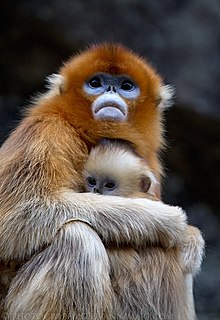Golden snub-nosed monkey
| Golden snub-nosed monkey | |
|---|---|
 |
|
| Scientific classification | |
| Kingdom: | Animalia |
| Phylum: | Chordata |
| Class: | Mammalia |
| Order: | Primates |
| Family: | Cercopithecidae |
| Genus: | Rhinopithecus |
| Species: | R. roxellana |
| Binomial name | |
|
Rhinopithecus roxellana Milne-Edwards, 1870 |
|
 |
|
| Golden snub-nosed monkey range | |
The golden snub-nosed monkey (Rhinopithecus roxellana) is an Old World monkey in the Colobinae subfamily. It is endemic to a small area in temperate, mountainous forests of central and Southwest China. They inhabit these mountainous forests of Southwestern China at elevations of 1,500-3,400 m above sea level. The Chinese name is Sichuan golden hair monkey (川金丝猴). It is also widely referred to as the Sichuan snub-nosed monkey. Of the three species of snub-nosed monkeys in China, the golden snub-nosed monkey is the most widely distributed throughout China.
Snow occurs frequently within its range and it can withstand colder average temperatures than any other non-human primates. Its diet varies markedly with the seasons, but it is primarily an herbivore with lichens being its main food source. It is diurnal and largely arboreal, spending some 97% of its time in the canopy. There are three subspecies. Population estimates range from 8,000 to 15,000 and it is threatened by habitat loss.
Biologists presently identify three subspecies of this monkey, which can be distinguished primarily by the length of their tails, as well as by certain skeletal and dental features. The dense human settlement of much of eastern Sichuan and the Han River valley of southern Shaanxi creates geographical separation between the three subspecies.
The adult and subadult golden snub-nosed monkey is sexually dimorphic.
Adult males (estimated at over 7 years of age) have large bodies covered with very long, golden guard hairs on their backs and cape area. The crest is medium brown while the back, crown to nape, arms and outer thighs are deep brown. The brown crest also contains physically upright hairs, which the shape are useful for individual identification. Also, when their mouths are open, researchers can observe long canines.
...
Wikipedia

